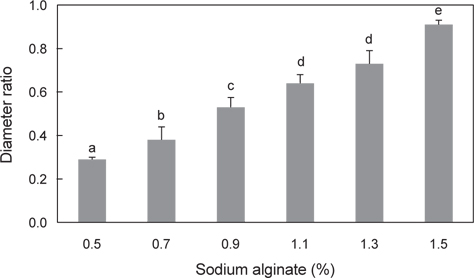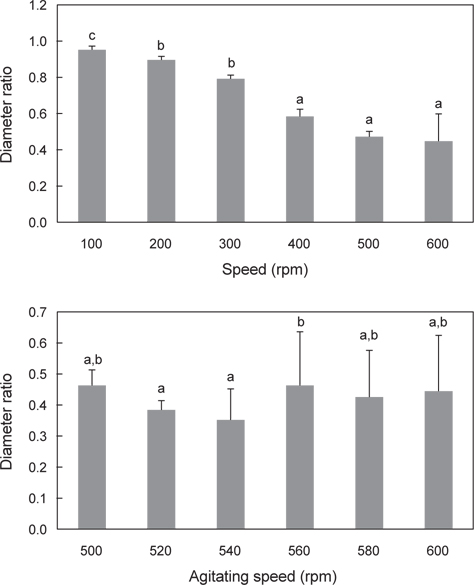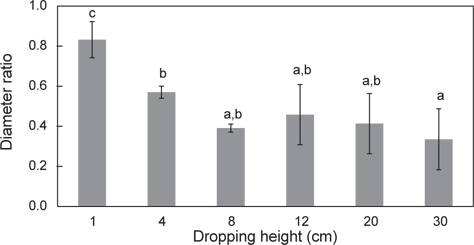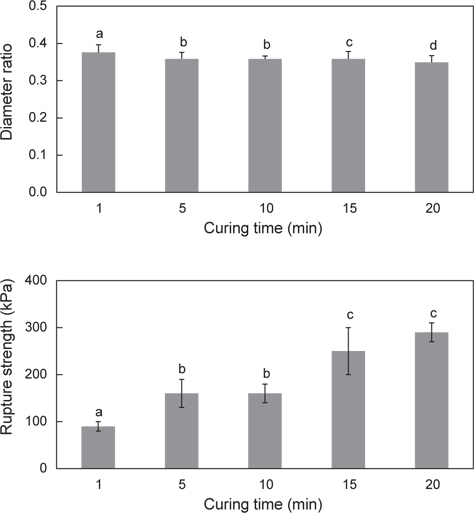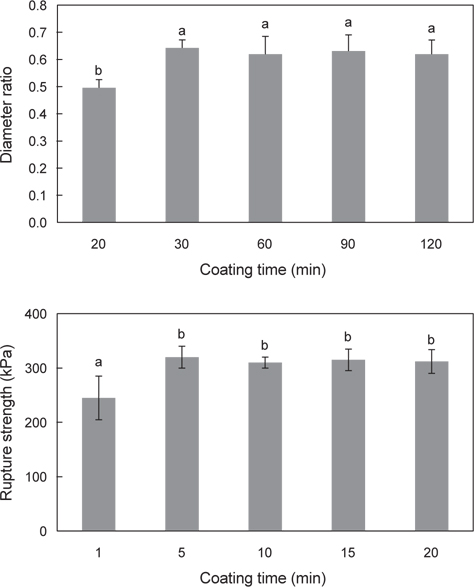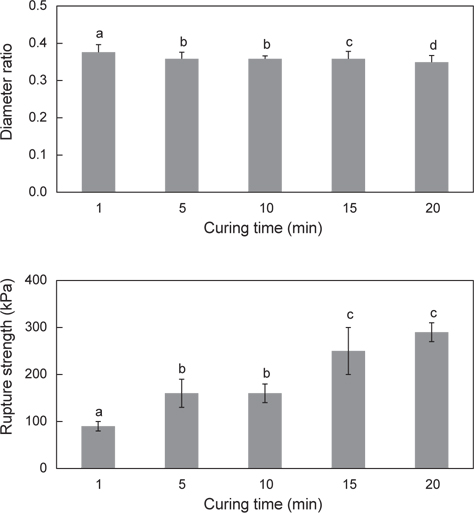



갈조류에 함유되어 있는 주요 다당류인 alginate는 캡슐화에 사용되는 가장 보편적인 고분자 물질 중의 하나이다. Alginate는 sol과 gel의 두 가지 특성을 다 가지고 있어 식품 및 바이오 분야뿐만 아니라 직물 인쇄, 종이 코팅, 의약품, 화장품, 애완견 사료 등의 여러 분야에서 널리 이용되고 있다(Onsoyen, 1996; Skjåk-Bræk and Espevik, 1996).
Alginate는 분자내의 guluronic acid의 carboxylic group에 2가의 양이온이 결합하여 ionotropic gels을 형성하는데, 이러한 alginate의 gel화는 주로 칼슘 이온의 첨가에 의해 guluronic acid의 G-block에 egg-box 모양의 3차원의 가교 구조의 형성에 의해 일어난다(Rousseau et al., 2004; Clark and Ross, 1987). 이러한 칼슘의 첨가에 의해 형성된 calcium alginate gel은 제조가 용이하고 물리적 강도가 좋아 단백질, 항산화제, 비타민, 생균제 등의 캡슐화의 주요 재료로 많이 이용되고 있다(Vandenberg et al., 2001; lyer et al., 2005; Chen and Subirade, 2007; Hansen et al., 2008).
Calcium alginate gel bead는 산에 약한 의약품을 위산으로부터 보호하여 장까지 도달할 수 있게 한다(Hwang et al., 1995). Koo et al. (2007)는 당뇨병의 치료 목적으로 alginate capsule을 최적화하여 췌장 세포의 세포 생존을 향상시키는 연구를 하였다. 또한 납 이온을 이용하여 alginate capsule과 alginate beads의 중금속 이온 흡착 정도에 대한 연구가 있다(Shin et al., 2007). Alginate gel은 점도가 높은 고지방 식품을 캡슐화 할 수 있는 장점이 있어 DHA 및 EPA를 함유하고 있는 어유의 캡슐화에 이용하고 있다(Blandno et al., 1999; Yun et al., 2015). 또한 alginate gel의 다공질 형성을 이용한 식품 스낵 분야의 적용(Nussinovitch and Zvitov-Marabi, 2008), calcium alginate gel의 구형성 최적화 연구(Woo et al., 2007)를 비롯하여 이를 응용한 캐비어 및 날치알 성형물의 제조(Ji et al., 2007; Jo et al.,2014)에 관한 연구 등이 있다.
Alginate는 gel의 형성이 쉽고 제조 조건이 단순하며 조작이 편할 뿐만 아니라 가열 안정성이 있고, 인체에 무해하고 경제적인 특징이 있다. 또한, sodium alginate가 경구 투여되면 포유류는 이를 소화시킬 효소가 없으므로 체내 흡수가 이루어지지 않고, cholesterol을 체외로 배출시키는 효과가 있어 다이어트 제품 개발에도 알맞은 소재이다(Keys et al., 1961; Walewijk et al., 2008).
따라서, 본 연구에서는 calcium alginate gel을 이용한 다이어트 쌀밥 제품을 개발하기 위하여 쌀밥과 최대한 유사하도록 sodium alginate solution 및 calcium chloride의 농도 (w/v), 용액의 교반 속도(rpm), 침투액과 반응액의 높이(cm)의 변화 및 열탕처리를 통하여 쌀밥과 유사한 형태의 cooked rice analog를 제조하는데 관여하는 물리화학적 인자의 영향을 해석하였다.
본 연구에서 사용한 β-carotene은 ㈜MSC사에서 제공받아 사용하였으며, β-cyclodextrin은 Sigma사(St. Louis, MO, USA)의 제품을 구입하여 사용하였다. Cooked rice analogs 제조를 위한 gel화 재료로는 sodium alginate (Katayama Chemical Co., Ltd., Japan)와 calcium chloride (Yakuri Pure Chemlcal Co., Ltd., Japan)를 사용하였다. 또한 본 연구에 사용된 모든 시약은 연구용 특급을 사용하였다.
Sodium alginate의 농도에 따른 cooked rice analogs의 특성과 최적 제조 조건을 알아보기 위하여 sodium alginate를 각각 0.5, 0.7, 0.9, 1.1, 1.3 및 1.5% (w/v)의 비율로 충분히 교반하였다. 이 혼합용액을 peristaltic pump (Cassette tube pump SMP-23, Eyela, Japan)를 이용하여 실리콘 튜브에 연결되어 있는 노즐로 calcium chloride (2%, w/v) 안정화 용액에 적하하여 제조하였다. 이때 혼합용액을 떨어뜨리는 시간은 2분으로 하였고, 반응조에서의 반응시간은 20분으로 안정화하였다. 이후 체를 이용하여 용액으로부터 cooked rice analog를 분리한 뒤, 정제수로 30초간 충분히 수세하고 저장하였다. 이 때 노즐은 내경 3.6 mm로 플라스틱 재질을 임의로 제조하여 사용하였고, 낙하거리는 노즐로부터 안정화 용액 표면까지의 거리로서 1, 4, 8, 12, 20 및 30 cm로 변화 조절하였으며 peristaltic pump의 유속은 0.04 mL/s로 고정하였다.
calcium chloride (2%, w/v) 안정화 용액이 담긴 반응조의 교반 속도는 cooked rice analog의 외형을 크게 좌우하므로 100에서 600 rpm까지 100 단위씩 구간을 두어 그 직경비의 특성을 살펴보고 500, 520, 540, 560, 580 및 600 rpm으로 세분화하여 최적화를 유도하였다.
β-cyclodextrin을 1% (w/v)로 용해시켜 상온의 상태로 냉각한 후 최적조건으로 제조된 cooked rice analogs를 시간 별로 침지한 후 건져내어 실온에서 2분간 건조시켰다.
컴퓨터와 연결된 광학현미경(BX-50, Olympus, Japan)을 이용하여 40배의 비율로 관찰하면서 Image-pro program을 이용하여, cooked rice analog의 크기를 측정하였다. 이때 cooked rice analog의 크기는 위의 조건 별로 제조된 것을 각각 5개씩 무작위로 골라낸 후 장경과 단경을 측정하여 직경비는 장경에 대한 단경의 비율로 나타내었다.
각각의 조건에서 제조된 cooked rice analog를 5개씩 골라내어 rheometer (Model CR-100D, sun Scientific Co., Ltd., Japan)를 사용하여 측정하였으며, 이때 사용한 plunger는 직경 10 mm의 원판형을 사용하였으며 테이플스피드, 최대하중, 이동거리는 각각 60 mm/min, 10 kg (Max 20 kg), 5 cm 로 설정하였다.
Cooked rice analog를 95℃ 이상에서 시간 별로 열탕 처리하였다.
각각의 시료에 대해 평균±표준오차(n=3)로 나타내었으며, 각군에 따른 유의차 검증은 분산분석을 한 후
>
Sodium alginate의 농도변화에 따른 cooked rice analog의 직경비 변화
Sodium alginate 농도에 따른 cooked rice analog의 특성과 최적 제조 조건을 알아보기 위하여 sodium alginate의 농도를 0.5%에서 1.5%까지 0.2% (w/v) 간격으로 비율을 달리하여 cooked rice analog를 제조하였으며, 그 크기의 측정 결과를 Fig. 1에 나타내었다. 그 결과, sodium alginate의 농도가 증가할수록 cooked rice analog의 직경비 역시 증가하였다. 즉, cooked rice analog의 장경에 대한 단경의 비인 직경비가 증가한다는 것은 sodium alginate의 농도가 증가할수록 cooked rice analog의 단경 역시 증가하여 전체적으로 구의 형태에 가까워진다는 것을 의미한다. Cooked rice (쌀밥)의 직경비인 0.38 (Table 1)과 비교하였을 때 sodium alginate 농도 0.7% (w/v)에서 cooked rice analog의 직경비가 0.39로 가장 유사하게 나타났다. 본 실험을 바탕으로 cooked rice analog의 외형을 좌우하는 요소 중 sodium alginate의 농도가 가장 크게 작용한다는 것을 알 수 있었다. 이런 결과는 Blandino et al. (2000)의 연구에서 calcium chloride과 sodium alginate의 농도에 따라 beads의 막 두께와 크기가 커진다는 것을 알 수 있었으며 뿐만 아니라 gel화 작용이 일어나는 반응시간에 따라서도 beads의 크기와 외형이 달라지는 것으로 나타났다.
[Table 1.] Diameter ratio and rupture strength of authentic cooked rice

Diameter ratio and rupture strength of authentic cooked rice
>
교반 속도의 변화에 따른 cooked rice analog의 직경비 변화
Sodium alginate 용액이 노즐로부터 적하되면 calcium chloride 용액 반응조 내에서 반응과 함께 교반이 이루어지며 cooked rice analog가 형성된다. 이때, 반응조에 담겨진 calcium chloride 용액의 교반 속도는 cooked rice analog의 모양 형성에 큰 영향을 준다. Alginate beads를 이용한 연구에서는 대부분 beads의 완전 구형을 원칙으로 하나, 본 연구에서는 분당 회전수가 높아질수록 원심력이 강하게 작용한다는 점에 착안하여 calcium alginate gel beads가 원형을 유지하지 못하도록 하여 cooked rice와 유사한 타원형을 유도하였다.
Fig. 2는 교반 속도의 변화에 따른 cooked rice analog의 장단경에 따른 직경비를 나타낸 것이다. 그 결과, calcium chloride 용액에서의 교반 속도 500 및 520 rpm에서 0.03 및 0.02의 편차를 보이다가 540 rpm 이후에서는 0.09 이상으로 그 차이가 급격히 증가함을 알 수 있었다. 일상생활에서 섭취하고 있는 cooked rice의 직경비 0.39와 비교하여 보았을 때 교반 속도 520 rpm에서의 cooked rice analog의 직경비가 0.39로 나타나 가장 유사하였다. 교반속도가 증가할수록 직경비가 다소 증가하는데 이는 원심력에 의한 결과로 회전력이 점차 커짐으로써 끝부분이 꼬리처럼 늘어지는 현상 (tailing)이 심하게 일어나 외형이 불규칙함에 기인한 것으로 생각된다.
>
낙하거리에 따른 cooked rice analog의 직경비 변화
노즐로부터 calcium chloride 용액 표면까지의 낙하거리를 1, 4, 8, 12, 20 및 30 cm로 조절하여 그 변화에 따른 cooked rice analog의 장단경에 따른 직경비를 Fig. 3에 나타내었다. 그 결과, 적하거리 8 cm 이후의 구간에서 직경비의 편차가 크게 나타났다. 이는 노즐로부터 calcium chloride 용액 표면까지의 거리가 멀어짐으로써 중력에 의한 가중화로 인하여 적하하는 액과 반응액이 마찰될 때 충격이 커지기 때문에 불규칙한 모양이 발생한다고 볼 수 있다.
>
Calcium chloride 침지 시간에 따른 cooked rice analog의 크기와 파열강도변화
Fig. 4는 calcium alginate gel화 특성을 이용하여 제조된 cooked rice analog를 calcium chloride 용액에 침지시켜 안정화 시간에 따른 직경비 및 파열강도를 나타낸 것이다. 그 결과, cooked rice analog의 장단경에 따른 직경비는 침지시간에 따라 감소하는 경향을 보였고, 그 편차는 또한 적어지는 것으로 나타났다. 한편, 파열강도는 침지시간이 증가함에 따라 크게 증가하여 침지시간 15분 이상에서는 유의적인 차이가 없었다. 침지시간 15분에서는 cooked rice (쌀밥)의 파열강도인 268.4 kPa(Table 1)에 근접한 것으로 나타나 직경비와 파열강도를 고려해 볼 때 calcium chloride 용액에 15-20분 침지하는 것이 유용한 것으로 나타났다. Cooked rice analog와 같은 gel beads는 uronic acid의 비율(Smidsroød, 1974; Draget et al., 1994), 안정액 내 존재하는 양이온 농도와 안정화 시간(Velings and Mestdagh, 1995; Ouverx et al., 1998) 등에 따라 그 특성이 달라지는 것으로 알려지고 있다. Won et al. (2005)는 beads가 안정화 될수록 그 크기는 작아지긴 하나 기능성 함유량엔 변화가 없다는 것을 알아냈다.
>
β-cyclodextrin 코팅 시간에 따른 cooked rice analog의 크기와 파열강도 변화
Fig. 5는 cooked rice analog를 calcium chloride 용액에서의 침지 시간을 20분으로 동일하게 하고 1% (w/v) ß-cyclodextrin코팅 시간을 각각 20, 30, 60, 90 및 120분으로 조절하여 그 물리적 특성을 나타낸 것이다. 그 결과, 직경비는 코팅 시간 20분으로 하여 제조하였을 경우 가장 낮아 cooked rice에 근접하는 것으로 나타났다. 그리고 파열강도는 코팅시간 5분에서 가장 높았고 그 이후에는 유의차가 없었다. 직경비와 파열강도를 고려할 때 ß-cyclodextrin 코팅시간은 20분이 유용한 것으로 나타났다. 코팅에 사용한 ß-cyclodextrin은 분자 내부의 소수성기가 콜레스테롤과 서로 높은 친화력이 있어서 콜레스테롤 제거에 효과적인 외부 흡착제로 알려져 있다(Yen and Tsui,1995).
>
열탕처리시간에 따른 cooked rice analog의 크기와 파열 강도 변화
Fig. 6은 열탕 처리를 시간 별로 달리 하였을 경우 cooked rice analog의 장단경에 따른 직경비 및 파열강도의 변화를 나타낸 것이다. 일반적으로 밥을 짓는 시간인 30분을 기준으로 하였을 때 밥을 짓고도 뜸을 들이거나 보온하는 등 cooked rice가 고온에서 방치되는 시간이 길다는 것을 고려하여, 제조된 cooked rice analog를 95°C에서 10, 20, 30, 40, 50, 60, 90 및 120분간 열탕처리 하였다. 각 시간에서 열탕처리 후 cooked rice analog를 체로 건져내어 정제수로 30초간 깨끗이 수세 후 냉각시켜 직경비와 파열 강도를 측정하였다. 그 결과는 가열처리에 따른 직경비는 30분을 기준하였을 때가 대체적으로 좋았고, 그 이후는 cooked rice analog의 직경에는 큰 변화가 없었다. 그리고 파열 강도는 직경비에 있어서와 같이 가열처리 30분 이후는 큰 변화가 적었으나 1시간 경과 후 파열강도는 다소 낮아지는 경향을 나타내었다. 열탕처리 시 작아지는 이유는 cooked rice analog 자체에 함유되어 있는 수분의 이탈에 기인하며, 30분 가열처리에서 파열강도가 증가하는 것은 calcium chloride에 의한 칼슘과의 결합량 증가에 의한 겔강도의 상승 때문으로 생각된다. Jo et al. (2014)은 열탕 처리시 다당류 피막물질을 코팅하는 방법으로 beads의 형태를 유지 및 강도에 도움을 준다고 보고하고 있다.
